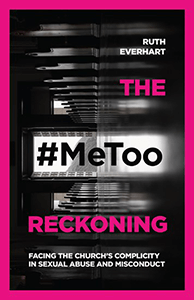Ruth Everhart, a pastor, author, and sexual assault survivor, outlines steps that any church can take to respond to the sexual victimization of women. Scripture, doctrine, honest conversation, and a commitment to creating safe spaces are important resources churches can employ in ministering to survivors and preventing future abuse.
One of the challenges facing today’s Church is the need to respond to the ongoing revelations that women have been sexually victimized by men for far too long. Each of us has something to contribute to the #MeToo movement. I find that church leaders are eager to respond to sexual assault but wonder how. What resources must we harness?
Congregations must realize that they already have a ministry to survivors: a ministry of absence. The truth is that when any necessary thing is withheld — be it food, water, or compassion — that powerful absence morphs into a presence of the opposite. In the case of sexual abuse, the absence of safeguards, accountability, and compassion can morph into the presence of evil.
Every church must acknowledge that its seats are occupied by both victims and victimizers. It’s time to rectify the power imbalances in church and society. It’s time to do justice.
1. Begin by telling your own story more honestly.
Countless congregations tiptoe around past sexual misconduct and abuse. Holding these secrets creates harmful patterns that lead to further breakdown as church members avoid difficult topics, distrust each other, blame others, and allow bullies to flourish.
2. Watch your language.
Words matter. It’s easy to hide ugly realities with vague phrases like “inappropriate touch” or “crossed boundaries.” Whenever possible, be more precise. The other day I heard a faith leader say that a youth pastor “had sex with” a sixteen-year-old. More correct: the perpetrator raped a sixteen-year-old.
3. Pluck the low-hanging fruit.
Post abuse hotline numbers in the church restrooms. Display resources about abuse prominently in the church library. Use the hashtag “#MeToo” on your church signage and media. If you need a reason, observe April as Sexual Assault Awareness month or October as Domestic Violence Awareness month. Advertise small groups for victims and survivors, both gender-segregated groups and mixed-gender groups. They are a success if a single person shows up. They are worth doing if no one at all shows up! The message will have gone out: we can talk about this subject here. Keep at it.
4. Be ready to move beyond talk therapy and provide access to trauma-informed care.
Become prepared for victims and survivors who might come to you for help. This means doing your own reading and finding qualified providers who take seriously the biology of trauma, especially its neurobiology. Trauma-informed care also focuses on safety for victims, especially in situations of domestic abuse. Intimate partner violence is very common, well-hidden, and uniquely dangerous.
5. Become a braver space.
Churches can and should make an effort in involve the whole congregation in ministry around sexual abuse. Hold open meetings to create a list of core values that will inform your church’s response to abuse and serve as an anchor when allegations arise. This list might include things such as telling the truth, caring for vulnerable persons, and speaking about things that are unspeakable. Draw on the resources of your tradition, whether that’s a particular historical emphasis, theological lens, or doctrinal viewpoint.
Besides the value of the finished product — the list of core values — there is the value of the process of creating it. The community-wide meetings will spark important conversations, especially if they’re structured to do so. To borrow a phrase from people working for racial reconciliation, these can be “courageous conversations.” Guidelines might include listening actively and attentively to others, assuming the best intentions of each other, speaking from our own experience, taking risks, extending grace, recognizing our own discomfort and resistance, and being willing to accept the impact of our words.
After your congregation learns how to hold brave conversations, continue by creating small groups where people can speak freely about the unexamined “gray areas” in their sexual lives. Remember that for everyone abused, there is an abuser. How many persons have a place to examine their sexual behavior through the lens of possible assault? If people look backward and realize they crossed lines in the past, create opportunities for confession and repentance, both communally and individually. Draw from your own tradition’s deep well of liturgy, music, and sacrament.
6. Become a safer space.
Many congregations have a protection policy. This needs to be revisited regularly by everyone who works with vulnerable populations. It should even be introduced to older children who work with younger children, framed as an expression of the church’s love and care, which it is.
Similar training should be expanded into more in-depth healthy boundary training for all staff members and mandated on an ongoing basis. If your denomination doesn’t provide this kind of training, excellent resources are available online. In addition, every member of your church staff needs to understand that they are mandated reporters. If that isn’t true according to the laws of your state, it is true in a moral sense. Every church leader, paid and unpaid, needs to know the exact steps they should follow if they suspect abuse. Make your commitments in writing perhaps using this example:
We will resist the impulse to handle abuse allegations “in house” and will report every allegation to law enforcement. We will report every allegation transparently to our church members, our denomination, and our larger community. We will budget resources for using outside experts for this difficult work. We will resist the temptation to treat sexual abuse and misconduct as a personal sin that can be confessed in private.
7. Use your unique resources.
Congregations have incredible assets that we sometimes undervalue. Two of these are scripture and doctrine. Scripture is a powerful response to sexual abuse and can be used to lift up the healing role of justice. Preachers can commit to regularly addressing sexual abuse in sermons, and church leaders can publicly support this commitment. Let people know of this decision in advance and revisit the topic regularly. In addition to sermons, sponsor Bible studies. These Bible study spaces can also become a place of courageous conversation.
I know that my personal belief system has been reshaped by my experience as a survivor. I say this without embarrassment because Scripture reminds us that God is continually doing a new work in us (Philippians 1:6) and that we are working out our salvation in fear and trembling (Philippians 2:12). Grappling with abuse need not destroy faith, but it can enrich and deepen it. As the angels remind us mortals, “do not fear.”
 Taken from The #MeToo Reckoning by Ruth Everhart. ©2020 by Ruth H. Everhart. Used by permission of InterVarsity Press. www.ivpress.com.
Taken from The #MeToo Reckoning by Ruth Everhart. ©2020 by Ruth H. Everhart. Used by permission of InterVarsity Press. www.ivpress.com.
#Me Too Reckoning Workshop Offered in a self-paced, online format. https://rutheverhart.com/self-paced-course/
Rev. Ruth Everhart and Dr. Eileen Campbell-Reed have collaborated to create a four-week online course for clergy and volunteer church leaders. Now the course is available in a self-paced, online format. It includes four session videos, 20+ downloadable handouts, and ideas for Bible study, worship, advocacy, and action.
Related Resources
- The Church’s #MeToo Reckoning featuring Ruth Everhart — Leading Ideas Talks podcast episode | Podcast video | In-depth interview
- Keeping Our Sacred Trust — online courses on sexual ethics and ethical boundaries in ministry offered by the Lewis Center for Church Leadership
- 3 Actions Churches Should Take in Light of #MeToo by Phill Martin
- 7 Ways Congregations Can Respond to the #MeToo Movement by General Commission on the Status and Role of Women







